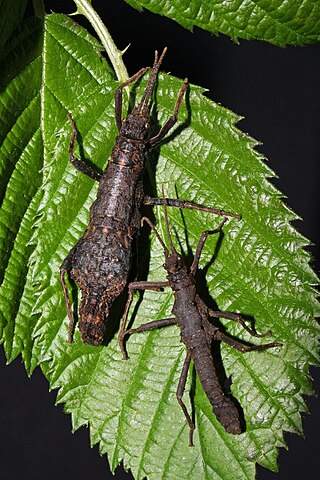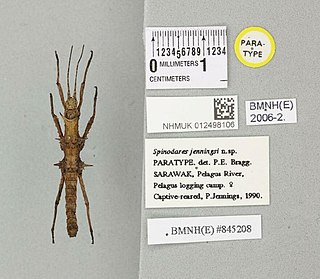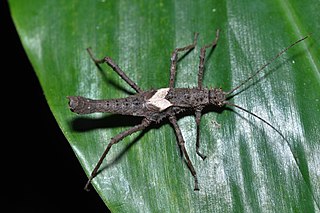
Squat lobsters are dorsoventrally flattened crustaceans with long tails held curled beneath the cephalothorax. They are found in the two superfamilies Galatheoidea and Chirostyloidea, which form part of the decapod infraorder Anomura, alongside groups including the hermit crabs and mole crabs. They are distributed worldwide in the oceans, and occur from near the surface to deep sea hydrothermal vents, with one species occupying caves above sea level. More than 900 species have been described, in around 60 genera. Some species form dense aggregations, either on the sea floor or in the water column, and a small number are commercially fished.

The abdomen is the front part of the torso between the thorax (chest) and pelvis in humans and in other vertebrates. The area occupied by the abdomen is called the abdominal cavity. In arthropods, it is the posterior tagma of the body; it follows the thorax or cephalothorax.

Cherax parvus is a species of crayfish in the family Parastacidae. It is only known from its type locality – the Upper Tully River catchment in the Cardwell Range of north-eastern Queensland – and is listed as data deficient on the IUCN Red List. It was discovered in a rainforest catchment in a highland of northeastern Queensland during a Queensland Museum expedition to the upper Tully River area in November 1992. It is one of the smallest species in the genus. No species of Cherax has been considered endemic to wet upland or highland areas before it was discovered; most previous records were from elevations less than 400 meters. It also has several morphological features unique to the genus, and does not appear closely related to any extant species, suggesting a long period of geographic isolation.
Procaris hawaiana is a species of shrimp in the family Procarididae, from Maui, Hawaii. The species is very similar to Procaris ascensionis from Ascension Island. In P. ascensionis the integument is less firm, the rostrum is shorter, the cervical groove is more distinct, and the third abdominal somite reaches less far posteriorly over the fourth; also the scaphocerite has the final tooth still less distinct than in P. hawaiana, and the last segment of its antennal peduncle is less slender.

Zigrasimecia is an extinct genus of ants which existed in the Cretaceous period approximately 98 million years ago. The first specimens were collected from Burmese amber in Kachin State, 100 kilometres (62 mi) west of Myitkyina town in Myanmar. In 2013, palaeoentomologists Phillip Barden and David Grimaldi published a paper describing and naming Zigrasimecia tonsora. They described a dealate female with unusual features, notably the highly specialized mandibles. Other features include large ocelli, short scapes, 12 antennomeres, small eyes, and a clypeal margin that has a row of peg-like denticles. The genus Zigrasimecia was originally incertae sedis within Formicidae until a second species, Zigrasimecia ferox, was described in 2014, leading to its placement in the subfamily Sphecomyrminae. Later, it was considered to belong to the distinct subfamily Zigrasimeciinae.

Torbenella insolita is a species of squat lobsters in the family Munididae. It occurs in the Pacific Ocean from Tonga to Papua-New Guinea and New Caledonia at depths between 120–470 m (390–1,540 ft).

Garymunida simillima is a species of squat lobster in the family Munididae. It occurs in French Polynesia. The specific name is derived from the Latin similis, which refers to its similarity to Agononida normani. The males measure from 12.4 to 13.5 millimetres and the females from 4.6 to 14.6 millimetres. It is found off of the Austral Islands, at depths between 200 and 1,000 metres.
Anoplonida inermis is a species of squat lobster in the family Munididae. The species name is derived from the Latin inermis, meaning unarmed, in reference to the lack of spines on the upper side of the carapace. The males measure, on average, from 2.6 to 3.9 millimetres, with the females, on average, measuring from 2.7 to 5.3 millimetres. It is found off of the Solomon Islands, at depths between about 135 and 325 metres, and off of both Central Queensland and New Caledonia, at depths ranging from about 295 to 400 metres.

Munida acantha is a species of squat lobster in the family Munididae. The species name is derived from the Greek acantha, meaning "spine", referring to the long distomesial spine on the base antennal segment. It is found near Atoll de la Surprise, and off New Caledonia and the Loyalty Islands, at depths between about 60 and 460 metres. The males are usually between 5.8 and 12.6 millimetres long, with the females being between about 4.5 and 11.4 millimetres long.
Munida aequalis is a species of squat lobster in the family Munididae. It was first described in 2004 by Shane Ahyong and GartyPoore. The species name is derived from the Latin aequalis, meaning "like" or "same", referring to the similar size of the terminal spines of the basal antennular segment. It is found northwest of Tweed Heads, New South Wales to near Wooli, New South Wales, at depths between about 150 and 550 metres. The males are usually between 14.0 and 41.5 millimetres long, with the females being between about 19.1 and 28.5 millimetres long.
Munida albiapicula is a species of squat lobster in the family Munididae. The specific epithet is derived from the combination of the Latin albus, meaning "white", and apiculus, meaning "tip", referring to the white tips of the supraocular spines. The males usually measure up to 20.7 millimetres (0.81 in), with the females measuring up to 16.9 millimetres (0.67 in). It is found off of the north east coast of Taiwan, at depths between about 50 and 450 metres.

Orestes bachmaensis is a Phasmatodea species native to central Vietnam.

Dares murudensis is a relatively small species of stick insect. Like most other members of the genus Dares, the species is native to Borneo.
Trachyaretaon gatla is a species of Phasmatodea native to the Philippine island Palawan.
Munidopsis taiwanica, is a species of Munidopsis, a genus of squat lobster. Named after the type locality. Deepest known record for squat lobsters at 5491m in the Mariana Trench, and is the first confirmed species of squat lobster found in the mud volcano environment.

Microrestes robustus is a stick insect species native to northwestern Vietnam.

Spinodares is a monotypic stick insect genus endemic to Borneo, containing Spinodares jenningsi as the only valid species.

Haaniella parva is a species of stick insect from the subfamily Heteropteryginae and belongs to the representatives of the genus Haaniella native to Sumatra. It is their smallest representative.

Hexamunida is a genus of squat lobsters in the family Munididae. It was erected in 2022 when the then paraphyletic Agononida was divided into three lineages: Agononidasensu stricto and two new genera, Garymunida and Hexamunida. The genus name refers to the number of spines (six) along the anterior ridge of the second abdominal somite, whereas these spines number four in Agononida.
Obrimus quadratipes is a stick insect species from the family of Heteropterygidae native to the Philippine island of Luzon.













